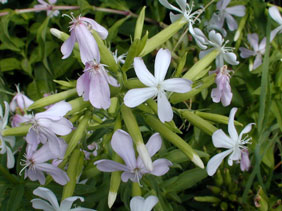BOUNCING BET
|
 |
| File Size: 80 KB |
|
|
|
Saponaria officinalis L.
|
| Riley County, Kansas |
| Perennial |
| Height: 12-30 inches |
| Family: Caryophyllaceae - Pink Family |
| Flowering Period: July, August, September |
|
| Also Called: | | Soapwort. | | Stems: | | Erect, stout, simple or sparingly branched, glabrous, waxy, prominent swollen nodes. | | Leaves: | | Opposite, simple, short-stalked or sessile, usually in 10-20 pairs, elliptic to elliptic-lanceolate, 1.5 to 4 inches long, .5 to 1.5 inches wide, glabrous; veins 3, parallel, prominent; tips pointed; lower leaves usually absent at flowering. | | Inflorescences: | | Cyme, up to 6 inches long, terminal or in upper leaf axils. | | Flowers: | | Showy, fragrant, about 1 inch across; calyx green or purplish, not ribbed; lobes 5, triangular; petals 5 (sometimes more), 1/3 to 3/5 inch long, clawed, white to pale pink, tips notched; stamens 10, exserted; styles 2. | | Fruits: | | Capsule, egg-shaped, about 3/5 inch long; seeds numerous, kidney-shaped to circular, flattened, dark brown. | | Habitat: | | Roadsides, waste areas, shelter belts, and fence rows. | | Distribution: | | Throughout Kansas; more frequently in east 1/3. | | Origin: | | Bouncing bet is native to Europe and now naturalized in the U.S. | | Uses: | | Europeans and Native Americans used the plant as a soap substitute. The crushed roots and leaves lather when mixed with water. The root juice was also used as a hair tonic. | | Comments: | | Reproduces via seeds and rhizomes; tends to be found in colonies. The seeds can cause digestive disturbance in livestock. |
|
| Bouncing bet flower |  | | 56 KB | | Riley County, Kansas |
| | Bouncing bet |  | | 94 KB | | Riley County, Kansas |
| | Bouncing bet |  | | 103 KB | | Riley County, Kansas |
| | Bouncing bet leaves |  | | 101 KB | | Riley County, Kansas |
| |
|
|
|
|
|
|